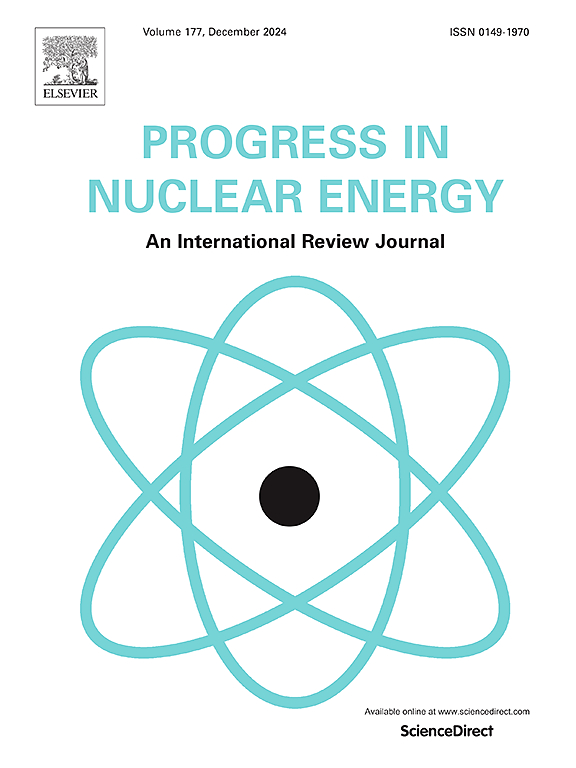A numerical study on single-phase heat transfer characteristics of the helical cruciform fuel assembly
IF 3.3
3区 工程技术
Q1 NUCLEAR SCIENCE & TECHNOLOGY
引用次数: 0
Abstract
In the presented work, the single-phase heat transfer behaviors of the 4 × 4 helical cruciform fuel (HCF) assembly is investigated by numerical simulation. The non-uniform wall temperature of the HCF element and the evolution of mean wall temperature along the rod length are analyzed. Besides, the effects of helical pitch and ratio of blade diameter and elbow diameter on the heat transfer are paid particular concern. According to the results, the wall temperature continues to increase along the path between the elbow and the blade lee side, and the peak wall temperature is always observed at the end of blade lee side. While the blades of the neighboring HCF elements getting closer, the mean wall temperature is increased by 1.2 °C–4.4 °C rapidly. The hot spots are generated with the rotation angle of n × 90°. By increasing the rotation angle, the heat transfer coefficient (HTC) of the HCF assembly continues to fluctuate with the maximum amplitude of ±10 %, and the rotation angle for the fluctuation period is 90°. With shorter helical pitch, the mean wall temperature is reduced while more hot spots are generated. In addition, the distribution of mean wall temperature along the rod length is almost not changed by the cross-section shape.
螺旋十字形燃料组件单相传热特性的数值研究
本文采用数值模拟方法研究了4 × 4螺旋十字形燃料(HCF)组件的单相传热行为。分析了HCF元件的非均匀壁温和平均壁温沿杆长变化规律。此外,还重点研究了螺旋距LHP和叶片直径与弯头直径比DR/ DR对换热的影响。结果表明,沿弯头至背风侧路径壁面温度持续升高,且壁面温度峰值始终出现在背风侧末端。随着相邻HCF单元叶片的靠近,平均壁面温度迅速升高1.2℃~ 4.4℃。热点产生的旋转角度为n × 90°。通过增加旋转角度,HCF组件的传热系数(HTC)以±10%的最大幅度持续波动,波动周期的旋转角度为90°。螺旋节距越短,平均壁面温度越低,产生的热点越多。此外,平均壁温沿杆长分布几乎不受截面形状的影响。
本文章由计算机程序翻译,如有差异,请以英文原文为准。
求助全文
约1分钟内获得全文
求助全文
来源期刊

Progress in Nuclear Energy
工程技术-核科学技术
CiteScore
5.30
自引率
14.80%
发文量
331
审稿时长
3.5 months
期刊介绍:
Progress in Nuclear Energy is an international review journal covering all aspects of nuclear science and engineering. In keeping with the maturity of nuclear power, articles on safety, siting and environmental problems are encouraged, as are those associated with economics and fuel management. However, basic physics and engineering will remain an important aspect of the editorial policy. Articles published are either of a review nature or present new material in more depth. They are aimed at researchers and technically-oriented managers working in the nuclear energy field.
Please note the following:
1) PNE seeks high quality research papers which are medium to long in length. Short research papers should be submitted to the journal Annals in Nuclear Energy.
2) PNE reserves the right to reject papers which are based solely on routine application of computer codes used to produce reactor designs or explain existing reactor phenomena. Such papers, although worthy, are best left as laboratory reports whereas Progress in Nuclear Energy seeks papers of originality, which are archival in nature, in the fields of mathematical and experimental nuclear technology, including fission, fusion (blanket physics, radiation damage), safety, materials aspects, economics, etc.
3) Review papers, which may occasionally be invited, are particularly sought by the journal in these fields.
 求助内容:
求助内容: 应助结果提醒方式:
应助结果提醒方式:


